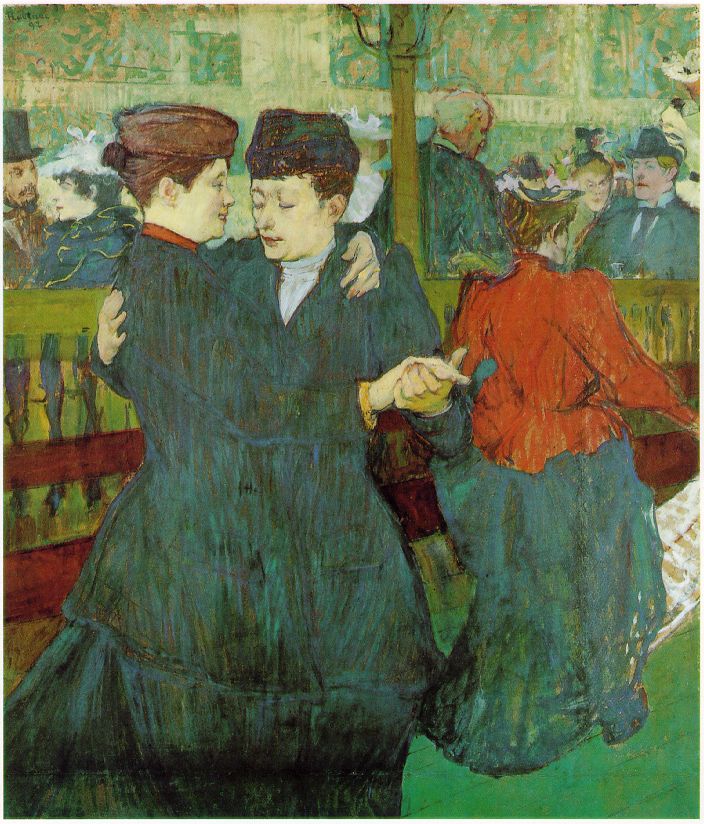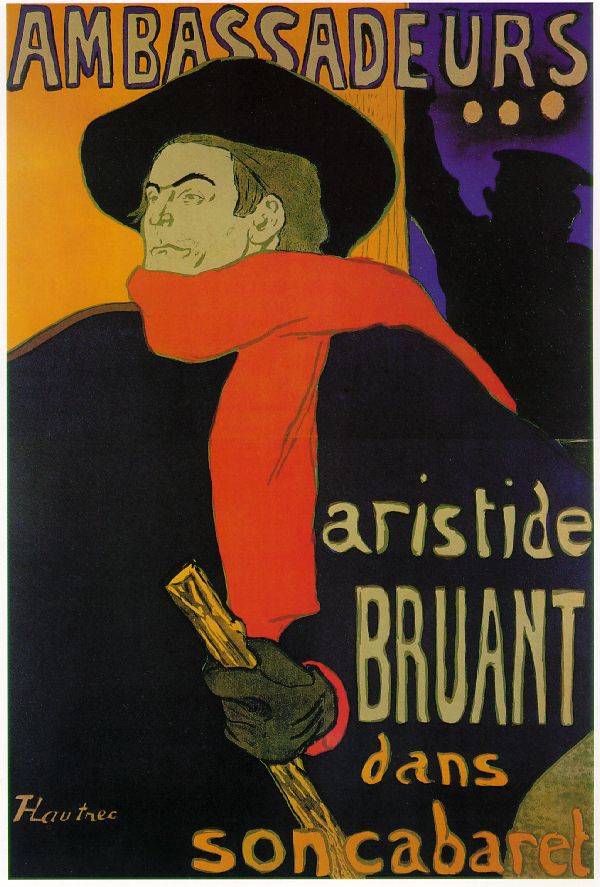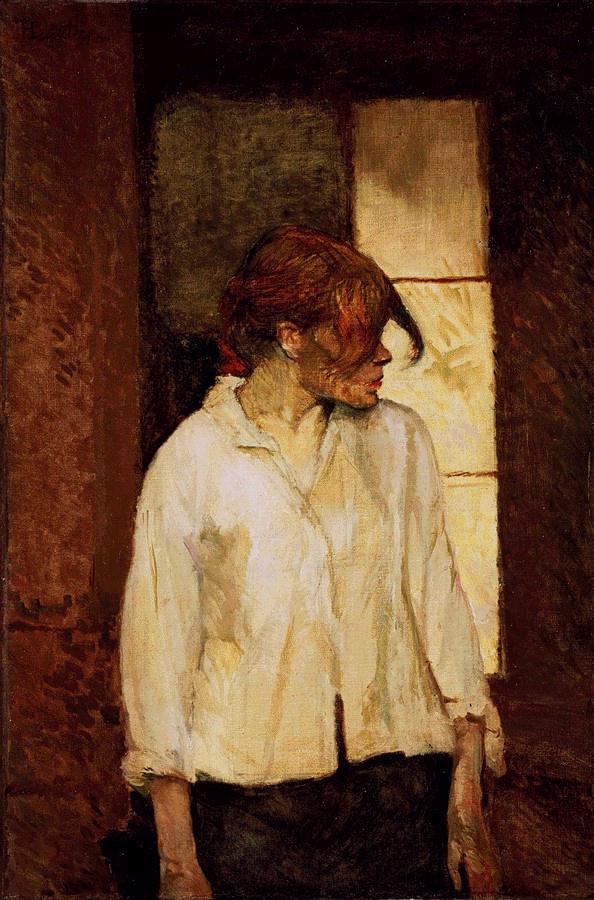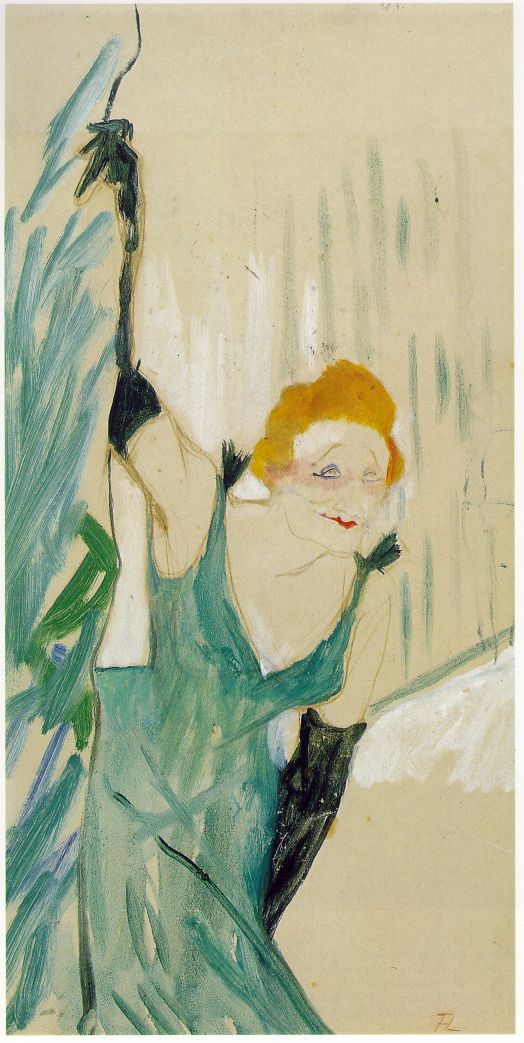Henri de Toulouse-Lautrec
- In this essay I will look at Lautrec's posters .
- How is Lautrec different than other impressionists working at the same time?…Monet
- How is his work similar?
*********************************************************************************************
Henri de Toulouse-Lautrec was french painter, desinger who was born in 19th century in town named Albi, France but most of the childhood he spent at the Château du Bosc which was the place his family owned near to his hometown Albi. Henris talent appeared at young age nearly about ten years old when he started sketching but also at his young age he broke both of his legs and that time he spopped to grow and that was his biggiest life problem. After years he moved to Paris where he started his art career.
Everything what starts from the beginning is always small , tiny and also simple and that applies for innovating artists like Henri de Toulouse Lautrec was with his brilliant idea of making, designing posters. He was first of his kind and I would say first graphic designer by that time who started to use printing technology and poster advertisement. Like I said he was first of the kind in that area and his works might look like that for us people in 21th century . In his work you can see how simply he designed those posters by using thick lines and big one-colored areas with basically no shading. I checked lot of his works and I found that he I would say he liked to play with black and yellow color plus sometimes not even using color at all , perhaps it was good idea of using those colors to get your attention from close of far distance , because I thing he knew that yellow color was visible. During the research I found that he designed fonts he were using in his posters and other stuff by hand some of them may look like done by the hand but also some of them look like he used some copied print font technology.
Compering him and other impressionist artists I think there was not big difference between them in terms of painting technology. They used same technology which were longer brush strokes. I would say than distinction was the concept of the painting. `most of impressionist artist like Monet painted for example nature of their country side and what and many times same picture from nature in different time like night,say,morning,sunset ect…but Lautrec didn't do that at all. He was focusing on portrait still or with action, always with some character that is the main distinction between him and other impressionists.
I like old school and his works surely are old school talking about the posters. Back in the days when he lived it was big boom for everybody , he laid down the rules which are used today , after one hundred years later. Like I said at the beginning in 19th century it seemed very modern but nowadays it would not fill demands of the present audience.
References:
Johnson, E., Whitten, C. (2003) Biography of Henri de Toulouse-Lautrec. Available at: http://www.lautrec.info/biography.html (Accessed: 1 March 2011).
Columbia University Press. (2001)Henri de Toulouse-Lautrec. Available at: http://www.globalgallery.com/artist_biography/henri+toulouse-lautrec/ (Accessed: 1 March 2011).
Renoir Fine Art Investments Inc. (1998-2008) Henri de Toulouse-Lautrec. Available at: http://www.renoirinc.com/biography/artists/lautrec.htm (Accessed: 1 March 2011).
========================================================================


Lautrec, H. (1892) Two Women Waltzing [Online]. Available at: ( http://www.ibiblio.org/wm/paint/auth/toulouse-lautrec/ (Accessed: 1 MArch 2011).

Lautrec, H. (1892) Ambassadeurs [Online]. Available at: ( http://www.ibiblio.org/wm/paint/auth/toulouse-lautrec/i/ambassadeurs.jpg (Accessed: 1 MArch 2011).

Lautrec, H. (1886-87) Rosa La Rouge - À Montrouge [Online]. Available at: ( http://www.ibiblio.org/wm/paint/auth/toulouse-lautrec/i/montrouge.jpg ) (Accessed: 1 MArch 2011).
Lautrec, H. (1891) Moulin Rouge [Online]. Available at: ( http://lh5.ggpht.com/_ZruT4rVUP-4/SfhU2yZNiOI/AAAAAAAAAjY/6p6be5C7oFM/toulouse-lautrec_-_moulin_rouge_-_la_goulue.jpg ) (Accessed: 1 MArch 2011).

Lautrec, H. (1894)Yvette Guilbert Greeting the Audience [Online]. Available at: ( http://www.ibiblio.org/wm/paint/auth/toulouse-lautrec/i/yvette-guilbert.jpg ) (Accessed: 1 MArch 2011).
Lutrec Research:
- french
- graphic,painter,desinger
- Paris
- posters
- hard life
- absint,own coctails
- broken legs
- El Greco, Velasques
- cycles ( cirkus )
- Moulin Rouge
- own style
Henri de Toulouse-Lautrec was born into an aristocratic family in the south of France in 1864. His father, Count Alphonse, was a notorious eccentric known for all kinds of unpredictable behavior: from washing his socks in the river (unheard of for an aristocrat!) to galloping off to a hunt wearing outlandish costumes, to simply disappearing for long stretches of time. The young Henri never became very close to him.
Unknown at the time, Henri suffered from a genetic condition that prevented his bones from healing properly. Fatefully, at age twelve, he broke his left leg. And at age fourteen, he broke his right leg. Both legs ceased to grow, while the rest of his body continued to grow normally.
At maturity, Lautrec was 4 1/2 feet tall. But his great misfortune was a sort of blessing in disguise, at least from our perspective. After his accidents he was no longer able to follow his father in the typically aristocratic pastimes of riding and hunting. Instead, he focused on sketching and painting.
http://www.lautrec.info/biography.html
Count Henri de Toulouse-Lautrec was born in Albi in one of the castles of his ancestors, the Counts of Toulouse. He was a delicate child, but led a normal life until he was fourteen. Then, in minor accidents, he broke first one thigh bone and then the other. Since he had shown talent in drawing as a very young child, his parents encouraged him to take lessons with various teachers in Paris.
http://www.dropbears.com/a/art/biography/Henri_de_Toulouse_Lautrec.html
As the artist's stature grew, several magazines wanted to publish his work, including Le Rire. His subjects, as well as street life, included some of the most famous music-hall performers, with whom he became friends, such as Yvette Guilbert, La Goulue Jane Avril, May Milton, May Belfort and several others.
http://www.yaneff.com/html/artists/lautrec.html
Virtually all posterists, then and since, have had to make their stance somewhere between these two poles. True, some may have tried a satirical bite more vicious than Toulouse-Lautrec's, or a neutrality even more profound than Cheret's, but none could surpass the sheer mastery of the pioneers. The best proof is that a century later, their work still sparkles with all its force, inventiveness and beauty, and each in his way is more popular than they ever were in their own lifetimes.
However, the years of night life and excessive intake of absinthe began to take their toll, and his physical condition became very fragile. He had to be taken through the Paris World's Fair of 1900 in a wheel-chair, and the following year he died in his country home.His legacy in poster art continues to astound us. Despite the smallness of his output (Cheret created almost 1000 posters) as compared to the rest of his artistic oeuvre, Toulouse-Lautrec proved himself a true genius of the poster, and his position in the poster pantheon has never been seriously challenged
http://www.yaneff.com/html/artists/lautrec.html
Lautrec's lifestyle could not be sustained. In 1899 he entered what we would today call a detox clinic.In September, 1901 — just over one hundred years ago — he passed away at the age of 36.As he lay dying, his mother and a few friends sat at his side. When his father, the rarely-seen Count Alphonse showed up, everyone was astonished — except Henri. He said, "Good Papa. I knew you wouldn't miss the kill."During Henri's last hours, Count Alphonse behaved as strangely as ever. The count suggesting that they cut off Henri's beard in accordance with certain Arabic customs that he'd heard of, and that they use Henri's shoelaces to flick at noisy flies. Henri's last words were addressed to his father: "Old fool."
http://www.lautrec.info/biography.html
Toulouse-Lautrec sought to capture the effect of the movement of the figure through wholly original means. For example, his contemporary Edgar Degas (whose works, along with Japanese prints, were a principal influence on him) expressed movement by carefully rendering the anatomical structure of several closely grouped figures, attempting in this way to depict but one figure, caught at successive moments in time. Toulouse-Lautrec, on the other hand, employed freely handled line and colour that in themselves conveyed the idea of movement. Lines were no longer bound to what was anatomically correct; colours were intense and in their juxtapositions generated a pulsating rhythm; laws of perspective were violated in order to place figures in an active, unstable relationship with their surroundings. A common device of Toulouse-Lautrec was to compose the figures so that their legs were not visible. Though this characteristic has been interpreted as the artist’s reaction to his own stunted, almost worthless legs, in fact the treatment eliminated specific movement, which could then be replaced by the essence of movement. The result was an art throbbing with life and energy, that in its formal abstraction and overall two-dimensionality presaged the turn to schools of Fauvism and Cubism in the first decade of the 20th century.
The originality of Toulouse-Lautrec also emerged in his posters. Rejecting the notion of high art, done in the traditional medium of oil on canvas, Toulouse-Lautrec in 1891 did his first poster, Moulin Rouge—La Goulue. This poster won Toulouse-Lautrec increasing fame. “My poster is pasted today on the walls of Paris,” the artist proudly declared. It was one of more than 30 he would create in the 10 years before his death.
http://www.britannica.com/EBchecked/topic/600695/Henri-de-Toulouse-Lautrec
Žádné komentáře:
Okomentovat